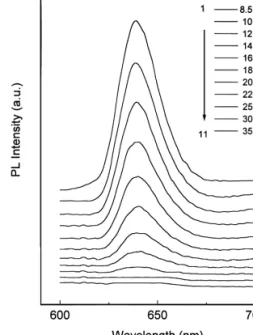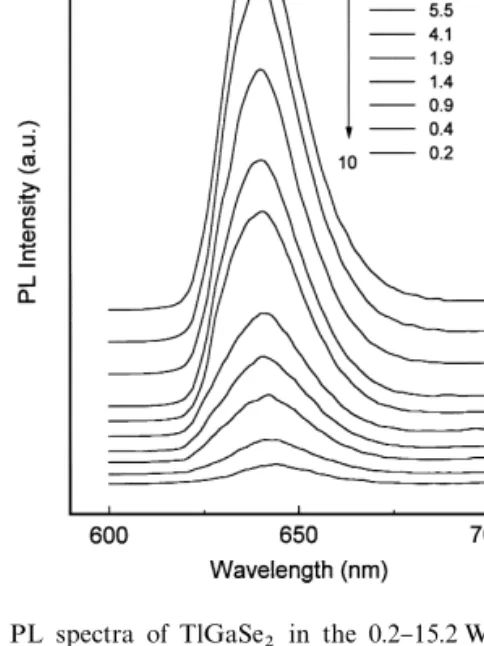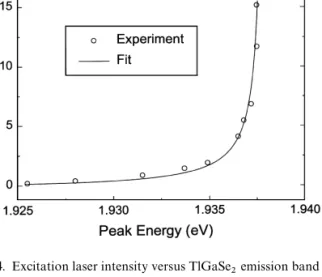* Corresponding author. Tel.: 210-5054; fax:
90-312-210-1281.
1 On leave from Physics Department, Baku State University, Baku, Azerbaijan.
E-mail address: nizami@metu.edu.tr (N.M. Gasanly)
Low-temperature visible photoluminescence spectra
of TlGaSe2 layered crystal
N.M. Gasanly
!,*,1, A. Serpengu
K zel
", A. Aydιnlι", S.M.A. Baten!
!Physics Department, Middle East Technical University, 06531 Ankara, Turkey"Physics Department, Bilkent University, 06533 Ankara, Turkey
Received 26 May 1999; received in revised form 14 September 1999; accepted 14 September 1999
Abstract
The photoluminescence (PL) spectra of TlGaSe2 layered single crystals were investigated in the 8.5}35 K temperature, 0.2}15.2 W cm~2 excitation laser intensity, and in the 600}700 nm wavelength range. The PL spectrum has a slightly asymmetric Gaussian lineshape with a peak position located at 1.937 eV (640 nm) at 8.5 K. The PL is quenched with increasing temperature. The blue shift of the PL peak and the sublinear increase of the PL intensity with increasing laser intensity is explained using the inhomogenously spaced donor}acceptor pair recombination model. Analysis of the data indicates that the PL band is due to donor}acceptor recombination. A shallow acceptor level and a moderately deep donor level are, respectively, introduced at 0.012 eV above the top of the valence band and at 0.317 eV below the bottom of the conduction band. An energy-level diagram for radiative donor}acceptor pair recombination in TlGaSe2 layered single crystals is proposed ( 2000 Elsevier Science B.V. All rights reserved.
PACS: 71.20.!b; 71.20.Nr; 78.20.!e; 78.55.!m
Keywords: Semiconductors; Photoluminescence; Impurity level; TlGaSe2
1. Introduction
Recently, ternary thallium chalcogenides re-ceived a great deal of attention due to their optical and electrical properties in view of possible op-toelectronic device applications [1}4]. These III}III}VI2 family of crystals have both layered (e.g., TlGaS2, TlGaSe2, TlInS2) and chain (e.g.,
TlInSe2, TlInTe2, TlGaTe2) structures. At room temperature, layer-structured thallium chalcogen-ide crystals belong to the monoclinic system, and their space group is C2/c. The crystal lattice con-sists of alternating two-dimensional layers ar-ranged parallel to the (0 0 1) plane. Each successive layer is rotated by a 903 angle with respect to the previous layer. Long-wave optical phonons in these crystals were investigated by infrared re#ection and Raman scattering experiments [5]. Recently, we have studied the photoluminescence (PL) of TlGaS2 and TlInS2 single crystals [6,7], and ob-served broad emission bands, which we have at-tributed to donor}acceptor pair recombination.
0022-2313/00/$ - see front matter ( 2000 Elsevier Science B.V. All rights reserved. PII: S 0 0 2 2 - 2 3 1 3 ( 9 9 ) 0 0 1 7 4 - X
Fig. 1. PL spectra of TlGaSe2 in the 8.5}35 K temperature range at ¸"15.2 W cm~2.
In the present paper, we report the results of the PL investigation of single crystals of TlGaSe2, which has a band gap of E'"2.187 eV at ¹"8.5 K and dE'/d¹"!2]10~4 eV/K [8,9]. The PL investigation is conducted within the 600}700 nm wavelength, 0.2}15.2 W cm~2 excita-tion laser intensity, and in the 8.5}35 K temper-ature range. The PL spectra and their tempertemper-ature and excitation intensity dependencies were studied in detail in order to propose a model for the recom-bination process of photoexcited carriers and a scheme for the impurity levels.
2. Experimental
TlGaSe2 polycrystals were synthesized from high purity elements(at least 99.999% pure) pre-pared in stoichiometric proportions. Single crystals of TlGaSe2 were grown by the modi"ed Bridgman method. No intentional doping of the crystals were performed. The analysis of X-ray di!raction data showed that, TlGaSe2 crystallizes in a monoclinic unit cell with lattice parameters: a"10.756 As ,
b"10.730 As and c"15.596 As and b"99.923. The
samples were prepared by cleaving an ingot parallel to the crystal layer, which was perpendicular to the
c-axis. The typical sample dimensions are 4]2]1 mm3. The electrical conductivity of the studied samples was p-type as determined by the hot probe method. A`Spectra-Physicsa argon ion laser operating at a wavelength 514.5 nm (2.410 eV) was used as the excitation source. The PL was observed from the laser illuminated face of the samples, in a direction close to the normal of the (0 0 1) plane. A `CTI-Cryogenics M-22a closed-cycle helium cryostat was used to cool the samples from room temperature down to 8.5 K. The tem-perature was controlled within an accuracy of 0.5 K. The PL spectra in the 600}700 nm wavelength range were analyzed using a `U-1000 Jobin-Yvona double grating spectrometer and a cooled GaAs photomultiplier tube equipped with the necessary photon counting electronics. A set of neutral-density "lters was used to adjust the excita-tion laser intensity from 0.20 to 15.2 W cm~2. This excitation laser intensity is the mean value of the laser intensity over the Gaussian spatial pro"le of
the laser beam. The PL spectra have been corrected for the spectral response of the optical apparatus.
3. Results and discussion
Fig. 1 shows the PL spectra of the TlGaSe2 crystal measured in the 600}700 nm wavelength and in the 8.5}35 K temperature range at a con-stant excitation laser intensity of 15.2 W cm~2. We observed a broad PL band centered at 640 nm (E1"1.937 eV) at 8.5 K. The PL spectra have a Gaussian lineshape with a slight asymmetry. The PL intensity decreases, and the PL peak energy position slightly shifts towards lower energies with increasing temperature, and disappears at 35 K. These features are typical of PL, which is due to donor}acceptor pair transitions observed in ter-nary semiconductors [7,10}12]. The red shift of the donor}acceptor emission in ternary chalcogenides was explained [11] by the transition involving do-nor and acceptor levels bound strongly to the band edge.
The variation of the PL peak with respect to temperature is plotted in Fig. 2. In the 8.5}18 K
Fig. 2. Temperature dependence of TlGaSe2 PL intensity at the emission band maximum. The arrow at 18 K shows the starting
point of the intensive quenching. Fig. 3. PL spectra of TlGaSe2 in the 0.2}15.2 W cm~2 laserintensity range at 8.5 K.
range, the PL intensity decreases slowly. Above 18 K, however, the PL intensity decreases at a lar-ger rate due to a thermal quenching process. The activation energy *E for this thermal quenching process can be derived in the 18}35 K temperature range using a nonlinear least-squares "t to the following equation:
I"I0 exp (*E/kB¹), (1)
where I is the PL intensity, I0 a proportionality constant, and kB the Boltzmann's constant. The semilog plot of the emission band intensity as a function of the reciprocal temperature gives a straight line in the 18}35 K region. An activation energy of E!"0.012 eV for the emission band is derived from the slope of the straight line "t. Since the TlGaSe2 crystal is a p-type semiconductor, we consider that the impurity level is an acceptor level
a located at 0.012 eV above the top of the valence
band. This shallow acceptor level a in undoped TlGaSe2 layered crystal may be associated with the presence of defects and unintentional impurities [13].
Fig. 3 presents the PL spectra for 10 di!er-ent laser intensities at 8.5 K. The observed PL band slightly shifts towards higher energies
(*E1"11 meV) with increasing excitation inten-sity from 0.2 to 15.2 W cm~2 (i.e., 6 meV per decade of excitation laser intensity). This behaviour is a characteristic of the donor}acceptor pair recom-bination [14,15]. In donor}acceptor pair recombi-nation, photoexcited carriers trapped at ionized donors and acceptors recombine radiatively. At low-excitation laser intensities only a small fraction of the donor and acceptor levels trap carriers. This leads to recombination from distant pairs only. At large enough excitation laser intensities more im-purity levels trap carriers which lead to a contribu-tion from closer pairs as well. The energy of the emitted photon during a donor}acceptor pair transition has a positive contribution from a Coulombic interaction between ionized impu-rities. This contribution increases as the separation between the pairs decrease [15]. Furthermore, radi-ative transition probabilities for di!erent pair sep-arations are di!erent and decrease exponentially as a function of the pair distance [16]. We, therefore, observe a shift of the emission band peak energy to higher energy as the intensity of the excitation laser increases.
The semilog plot in Fig. 4 shows the excitation laser intensity (¸) as a function of the emission band
Fig. 4. Excitation laser intensity versus TlGaSe2 emission band peak energy at 8.5 K. The solid curve gives the theoretical "t using Eq. (2).
Fig. 5. Dependence of TlGaSe2 PL intensity at the emission band maximum versus excitation laser intensity at 8.5 K. The solid curve gives the theoretical "t using Eq. (3).
peak energy (E1) at 8.5 K. The experimental data in Fig. 4 is then "tted by the following equation [17]: ¸(E1)"¸0 (E1!E=)3
(EB#E=!2E1) ]exp
A
!2(EB!E=)E1!E=
B
, (2)where ¸0 is a proportionality constant, EB the emitted photon energy of a close donor}acceptor pair separated by a shallow impurity Bohr radius (RB), and E= the emitted photon energy of an in"nitely distant donor}acceptor pair. From a non-linear least-squares "t of Eq. (2) to the experimental data, the photon energy values for an in"nitely distant donor}acceptor pair and a close donor} acceptor pair separated by RB are found to be
E="1.858 eV and EB"2.018 eV, respectively.
These limiting photon energy values are in good agreement with the band-gap energy (E'" 2.187 eV) and the observed values of the peak energy position (i.e., E=(1.926 eV(E1( 1.937 eV(EB(E') at 8.5 K.
We have also investigated the intensity variation of the maximum of the emission band versus the excitation laser intensity at ¹"8.5 K (Fig. 5). The experimental data can be "tted by a simple power law:
IJ¸c, (3)
where I is the PL intensity, ¸ the excitation laser intensity, andc a dimensionless exponent. It was found that, the PL intensity increases sublinearly (i.e., c"0.75) with respect to the excitation laser intensity (Fig. 5). Saturation of the PL starts at ¸'6.8 W cm~2. For an excitation laser photon with an energy exceeding the band-gap energy E', the coe$cientc is generally 1(c(2 for the free-and bound-exciton emission, free-andc41 for free-to-bound and donor}acceptor pair recombination [18]. Thus, the obtained value ofc"0.75 con"rms our assignment of the observed emission band in TlGaSe2 is due to donor}acceptor pair recombination.
The analysis of the PL spectra as a function of temperature and excitation laser intensity allows one to obtain a possible scheme for the donor} acceptor levels located in the forbidden energy gap of the TlGaSe2 crystal. These donor}acceptor levels are involved in the radiative recombination of the photoexcited carriers observed in this work. In our proposed scheme (Fig. 6), a shallow acceptor level a located at 0.012 eV above the top of the valence band, is introduced into the forbidden en-ergy gap of TlGaSe2.
On the basis of general expression for the emis-sion energy of donor}acceptor pair [15] and taking into account E' and E=, the sum of the activation energies of the donor (E$) and acceptor (E!) levels,
Fig. 6. Proposed energy-level diagram of TlGaSe2 at 8.5 K.
involved in the emission band, has been estimated as being
E$#E!"E'!E="2.187 eV!1.858 eV
"0.329 eV. (4) Consequently, a donor level d, located at 0.317 eV below the bottom of the conduction band, is introduced into the forbidden energy gap of TlGaSe2. We propose that the moderately deep donor level in p-type TlGaSe2 layered crystal can be associated with stacking faults or dislocations, which are quite producible in these materials, due to the weakness of the forces (van der Waals) be-tween adjacent layers. Similarly, moderately deep donor levels were also revealed in p-type GaSe layered crystal [13,19]. Taking into account the above assignments, we attribute the observed PL band to the radiative recombination of an electron occupying a donor level d (E$"0.317 eV) and a hole occupying an acceptor level a (Ea" 0.012 eV).
4. Conclusions
The analysis of the PL spectra as a function of temperature and excitation laser intensity allows one to obtain a possible model for the donor}ac-ceptor levels located in the forbidden energy gap of the TlGaSe2 crystal. Rapid thermal quenching of the PL band is observed above ¹"18 K indicat-ing the presence of a shallow impurity. This behav-ior was understood in terms of a shallow acceptor
level located at 0.012 eV above the valence band in p-type TlGaSe2.
A moderately deep donor level located at 0.317 eV below the conduction band, is then intro-duced into the energy-band diagram of TlGaSe2 crystal. The blue shift of the emission band peak energy with increasing excitation laser intensity is explained using the inhomogenously spaced donor}acceptor pair model. Moreover, the PL intensity increases sublinearly with respect to the excitation laser intensity and con"rms our assign-ment that the observed PL in TlGaSe2 is due to donor}acceptor pair recombination.
References
[1] K.A. Yee, A. Albright, J. Am. Chem. Soc. 113 (1991) 6474. [2] M.P. Hanias, A.N. Anagnostopoulos, K. Kambas,
J. Spyridelis, Mat. Res. Bull. 27 (1992) 25.
[3] N. Kalkan, J.A. Kalomiros, M. Hanias, A.N. Anagnos-topoulos, Solid State Commun. 99 (1996) 375.
[4] J.A. Kalomiros, N. Kalkan, M. Hanias, A.N. Anagnos-topoulos, K. Kambas, Solid State Commun. 96 (1995) 601. [5] N.M. Gasanly, A.F. Goncharov, N.N. Melnik, A.S. Ragimov, V.I. Tagirov, Phys. Stat. Sol. B 116 (1983) 427. [6] N.M. Gasanly, A. Aydιnlι, A. Bek, I0. Yιlmaz, Solid State
Commun. 105 (1998) 21.
[7] A. Aydιnlι, N.M. Gasanly, I0. Yιlmaz, A. Serpenguzel, Semicond. Sci. Technol. 14 (1999) 599.
[8] G.I. Abutalybov, I.Kh. Akopyan, I.K. Neimanzade, B.V. Novikov, E.Yu. Salaev, Sov. Phys. Solid State 27 (1985) 1710.
[9] C.S. Yoon, B.H. Kim, D.J. Cha, W.T. Kim, Jpn. J. Appl. Phys. 32 (Suppl. 3) (1993) 555.
[10] I.A. Damaskin, S.L. Pyshkin, S.I. Radautsan, V.E. Tezlevan, JETP Lett. 18 (1973) 142.
[11] H.G. Kim, K.H. Park, B.N. Park, H.J. Lim, S.K. Min, H.L. Park, W.T. Kim, Jpn. J. Appl. Phys. 32 (Suppl. 3) (1993) 476.
[12] N.M. Gasanly, A. Serpenguzel, A. Aydιnlι, O. Gurlu, I0 . Yιlmaz. J. Appl. Phys. 85 (1999) 3198.
[13] V. Capozzi, Phys. Rev. B 28 (1983) 4620.
[14] J.I. Pankove, Optical Processes in Semiconductors, Pren-tice-Hall, Englewood Cli!s, NJ, 1975, p. 8 and 150. [15] P.Y. Yu, M. Cardona, Fundamentals of Semiconductors,
Springer, Berlin, 1995, p. 348.
[16] J.P. Leyris, J.P. Aicardi, S. Soule, J. Lumin. 28 (1983) 65. [17] E. Zacks, A. Halperin, Phys. Rev. B 6 (1972) 3072. [18] T. Schmidt, K. Lischka, W. Zulehner, Phys. Rev. B 45
(1992) 8989.
[19] S. Shigetomi, T. Ikari, H. Nakashima, Phys. Stat. Sol. A 160 (1997) 159.



